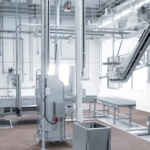
With advancements in automation, data management, and equipment, technology plays a pivotal role in enhancing efficiency, food safety, and animal welfare in abattoir design and processes.
This is an opinion piece or news article written by our staff.

From receiving animals to packaging the final product, stringent hygiene practices must be followed at every stage of the abattoir process. In this article, we will explore the importance of maintaining hygiene and food safety in abattoir processes and highlight the best practices that minimize contamination risks and promote consumer confidence.
Implementing robust sanitation protocols is crucial in maintaining a clean and hygienic abattoir environment. Establishing a regular cleaning schedule for all equipment, surfaces, and processing areas is essential. This includes proper sanitization of knives, cutting boards, and other utensils to prevent cross-contamination. Adhering to comprehensive cleaning procedures minimizes the risk of microbial growth and ensures the safety of the meat products.
Maintaining high standards of personal hygiene among abattoir staff is imperative to prevent any potential contamination. Proper training and education should be provided to employees on the importance of personal hygiene practices, including handwashing, wearing appropriate protective clothing, and adhering to strict cleanliness standards. Emphasizing personal hygiene helps reduce the risk of introducing harmful pathogens into the processing environment.
Temperature control is vital in preserving the quality and safety of meat products. Maintaining appropriate temperature conditions at various stages, including chilling, storage, and transportation, is critical to inhibit bacterial growth and prevent foodborne illnesses. Regular monitoring and documentation of temperatures ensure that products are stored and handled within safe temperature ranges.
To minimize cross-contamination, it is essential to separate different processing areas within the abattoir. Distinct areas for receiving, stunning, slaughtering, evisceration, and packaging help prevent the spread of contaminants between different stages of processing. Strict adherence to these separation protocols reduces the risk of microbial contamination and enhances food safety.
Hazard Analysis and Critical Control Points (HACCP) System: Implementing a Hazard Analysis and Critical Control Points (HACCP) system is a proactive approach to managing food safety risks in the abattoir. This systematic preventive approach identifies and controls potential hazards throughout the production process. By analyzing critical control points and establishing preventive measures, the HACCP system helps ensure the production of safe and high-quality meat products.
Regular training and certification programs for abattoir staff are crucial to maintain and enhance hygiene and food safety practices. These programs should cover topics such as proper handling of carcasses, identification and prevention of foodborne hazards, and compliance with regulatory requirements. Training ensures that all staff members are knowledgeable and equipped to implement effective food safety measures.
Establishing robust traceability systems and maintaining accurate records are essential aspects of ensuring food safety in abattoir processes. The ability to track and trace each batch of meat products from farm to fork allows for effective recall procedures if necessary. Detailed records of processing, packaging, and distribution provide crucial information in the event of a food safety investigation or audit.
Maintaining high levels of hygiene and food safety in abattoir processes is paramount to safeguarding public health and consumer confidence. By implementing robust sanitation protocols, emphasizing personal hygiene, ensuring proper temperature control, separating processing areas, implementing a HACCP system, providing comprehensive training, and establishing effective traceability and record-keeping systems, abattoirs can consistently produce safe and high-quality meat products. These best practices not only comply with regulatory requirements but also foster trust and credibility in the meat industry, benefiting both consumers and the abattoir itself.

With advancements in automation, data management, and equipment, technology plays a pivotal role in enhancing efficiency, food safety, and animal welfare in abattoir design and processes.

Abattoirs play a critical role in this journey, serving as the gateway where livestock are transformed into meat products.

When it comes to abattoir operations, there are different models to consider, including small-scale and large-scale facilities.

Compliance with these regulations is essential to protect public health, maintain industry reputation, and adhere to legal requirements.